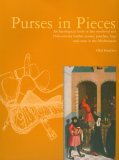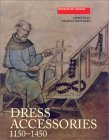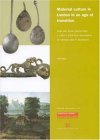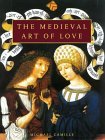|
This page has been reorganized to coordinate with the taxonomy of medieval bags, pouches, and purses in Purses in Pieces by Olaf Goubitz. Since his survey only covers late medieval and 16th century Dutch examples, I have included related earlier examples (as well as examples from beyond the Netherlands) as well. Since his survey only covers late medieval and 16th century Dutch examples, I have included related earlier examples (as well as examples from beyond the Netherlands) as well.
See also these links relating to pouches, purses, bags, and satchels. There are some details of men's purses at From the Skin Out as well (many of which appear below).
You should also read Purses for the Company of Saint George and On Carrying Things: Packs, Baskets, Bags and Bundles if you're interested in late 15th century examples; if alms-purses or embroidery interest you, see Aumônières, otherwise known as alms purses: Embellished textile purses in the European 14th century; there are several embroidered purses photographed and re-created at the Taschen blog as well.
Girdle purses
"The girdle purses is a leather, bag-shaped container with one or two loops on the top by which the purses is strung onto the girdle." (Goubitz 15-35) 15-35)
- Romance of Alexander (Bodley 264, including fols. 43v, 51v,
66r,
82v,
88v,
98r,
106r,
113v,
123v,
138v,
142v,
152v,
161v,
165r,
174r,
and 204r), c. 1338-44
- Wisdom is impervious to attack (fol. Hv), Wisdom protects the daughters of Gaston Phoebus (fol. Hv), A man (fol. 8v), dogs defend their master (fol. 242v), and hunting for beaver (fol. 242v), De proprietatibus rerum (Bibl. Sainte-Geneviève 1029), c. 1350
- The Marriage by Niccolò di Giacomo da Bologna , 1350s
- Jacob thrown into the well, Bible historiale (BNF Fr. 159, fol. 31v), 14th-15th century
- Fols.
40v,
51v,
53,
54,
55,
65,
86,
87,
92,
105v,
The Book of the Hunt of Gaston Phoebus (BNF Fr. 616), beginning of the 15th century
- Turnips (fol. 43), millet-bread (fol. 56), and mutton (fol. 61v), Tacuinum Sanitatis (BNF Latin 9333), 15th century
Girdle purses with decorative metal mounts
A style with fancy decorations on the flap. The best-known example can be seen in the Engelbrecht donor portrait below, but appears throuhgout the 15th century, and into the very beginning of the 16th century.
- A cheesemonger, Tacuinum Sanitatis (BNF Latin 9333, fol. 58v), 15th century
- Detail from The Crucifixion, c. 1420-1430
- Peter Engelbrecht in the Mérode Altarpiece by Robert Campin, 1427
- Jodocus Vyd from the Ghent Altarpiece by Jan van Eyck, 1432
- Joseph in The Holy Family at supper, The Hours of Catherine of Cleves (PML M.917, fol. 151), c. 1440
- Detail from The Crucifixion, 1457
- April, The Grimani Breviary, c. 1490-1510
- Diptych with Jean de le Cambe and St. John the Baptist, c. 1490-1510
- The Cure of Folly by Hieronymus Bosch, 1475-80
- November, The Grand Hours of Anne of Brittany (BNF Latin 9474, fol. 14), c. 1503-1508
- Chinese merchants, The Book of Marvels (BNF Fr. 2810, fol. 139), c. 1410-1412
- Detail from January in the Très riches heures du Duc de Berry, c. 1412-16
- Construction of a castle, The Government of Princes (Bibl. Sainte-Geneviève 1015, fol. 1), second quarter of the 15th century
- Detail from The miracles of St. Nicholas by Thomas von Klausenburg, 1427
- Detail from The Passion, c. 1445-1450
- St. Joseph from the St. Columba Altarpiece by Rogier van der Weyden, c. 1455
- Detail from St. George receives the poisoned bowl, c. 1465-1470
- Detail from The Adoration of the Magi, 1469-1480
- A farmer from a tapestry, c. 1470-1480
- A man opening his pouch, Kuttenberger Kantionale (ÖNB Mus. Hs. 15501, fol. 67r), 1490
- June, The Grimani Breviary, c. 1490-1510
- Comforting prisoners in the Works of Charity polyptich from St. Lawrence's Church in Alkmaar, 1504
- Orpiment mining, The Book of Simple Medicines (BNF Fr. 12322, fol. 168v), c. 1520-1530
- 17th century purse with heraldry and a laurel wreath
Pouch purses
"The pouch purse is a girdle purse with a single suspension loop." (Goubitz 41-42) 41-42)
- A bag with pouchlets (also here and here) from the nachlaß of Hermann von Goch, c. 1398
- Beans (fol. 44v) and wheat-harvesting (fol. 46v; note similarity to the pouch on the Walter de Helyon effigy), Tacuinum Sanitatis (BNF Latin 9333), 15th century
- Boccaccio has a discussion with jurists (fol. 99v), Boccaccio has a discussion with a group of men (fol. 101), Boccaccio discusses poetry (fol. 106v), Boccaccio has a discussion with the successors of Alexander (fol. 133), De casibus (Bibl. Sainte-Geneviève 1128, fol. 99v), second quarter of the 15th century
- Suicide of Lucretia, Facta et dicta memorabilia (Bibl. Mazarine 1595, fol. 272v), c. 1430
- Detail from The Circumcision of Christ, c. 1430-1435
- Repentence of David, a book of hours (Bibl. Mazarine 504, fol. 75), c. 1450-1460
- The Last Supper, by the Master of the Housebook
- Detail from The Liberation of St. Barbara by Hans Egkel, c. 1470-1480
- Detail, St. Mary Magdalene, c. 1490-1500
- Detail from The Visitation, c. 1490-1500
- Detail from St. Anne and St. Christopher, 1491
- Detail from The Birth of Mary by Hans Holbein the Elder, 1493
- A Nuremburg woman in house dress by Albrecht Dürer, c. 1500-1501
- Detail from The Visitation, 1503
- Detail from The Visitation by Sebastian Taig, c. 1518-1522
- Detail from the June section of the Augsburger Monatsbilder, 1520s
- Detail from the effigy of Lady Jane Dawtrey, 1542
- Interesting open image of a pouch with pouchlets in The Lovers by Lucas Cranach the Elder
Girdle bags
"Girdle bags are bag purses closed with a flap and may have girdle loops." (Goubitz 43-45) 43-45)
- Man's purse, 14th century, from Germany or Holland in stitched & embossed leather.
- Effigy of Walter de Helyon c. 1350-60
- Dried figs (fol. 2v),
lemons (fol. 18),
Anise (fol. 23v),
leeks (fol. 24),
coriander (fol. 31v),
licorice (fol. 41v)
Tacuinum Sanitatis (BNF Latin 9333), 15th century
- Gifts of the Holy Spirit (fol. 28v), Roboam and his subjects (fol. 79v), and the blinding of Sedecias (fol. 88), Speculum historiale (BNF Fr. 50), 1463
- Detail from The Passion, the Laufen Altar, 1467
- Generosity, The City of God (Bibl. Sainte-Geneviève 246, fol. 3v), c. 1475
- A prophet, a missal (Bibl. Mazarine 412, fol. 150), c. 1492
- Archery Festival, 1493
- Ptolemy I orders the exile of Jews in Egypt, Antiquitates judaicae (Bibl. Mazarine 1581, fol. 228), c. 1503
Framed purses
“A category of distinctive purses with metal frames and suspension features by which they are suspended from the girdle … From the frame, made of iron, tin-plated iron, brass, silver or gold, hangs the leather bag part of the purse. In later centuries, other materials too were used, mainly textile. The frame surrounds the purse’s aperture. Therefore it must be wide enough to admit a hand.” (Goubitz 47-59)
I have moved all of the framed purses (14th-17th century) to their own linkspage.
Money pouches or Drawstring pouches
"Pouches are bag-shaped leather or textile receptacles of thin and supple material." (Goubitz 61-69) 61-69)
I have moved all of the money pouches and drawstring pouches to their own linkspage.
Girdle pouches
"Some images show receptacles that show pouches carried closely below or on the girdle. Sometimes there is evidence of some kind of suspension loop, but often the top of the pouch appears to sit immediately on the girdle. This could be achieved with short loops on the back of the pouch. Also it is imaginable that the pouch is integral with the girdle. Its overall shape is similar to that of a pouch purse or pouch suspended from the girdle with a thong or strap." (Goubitz 71) 71)
Waist bundles
"Shepherds wore their plain, black leather girdle purses or bundles tied around the waist. Apparently, this bundle was strung through with a thong or strap, which after being tied left two loose ends. How exactly this worked and what constitutes the bulging shape ni the painting may only be guessed at. It could be a broad linen bag which after being partially rolled up, was tied around the waist so that it would not get in the way while the wearer was at work." (Goubitz 73) 73)
Examples and further discussion of these waist bundles can be found at the shepherds' budgets linkspage.
Money-changer's purses
"The money-changer's purse is in fact a pundle of pouches that was used especially by people who needed to deal with several different currencies ... The so-called money-changer's purses helped to keep apart as many currencies as possible. To this end, the purses incorporated not only several pouches, but also extra pouchlets stitched onto each pouch. Of course any type of purse with multiple compartments could serve this purpose ... Two principal types can be distinguished. one has a large central pouch surrounded by several smaller pouches, each with their even smaller pouchlets: what one might call a 'mother purse'. The other type has a stick handle, to which are attached four to six pouches, each with their pouchlets: a 'father purse'. All of the pouches and pouchlets were closed with a thong or strap according to the drawstring principle." (Goubitz 75-78) 75-78)
- Leather purse, c. 1304-1318
- Several versions of The Money-Changer and his Wife by Marinus van Reymerswaele:
Prado P02102 (1538),
Prado P02567 (1539),
Bargello 213 (1540),
Koninklijk Museum voor Schone Kunsten (c. 1551-1567),
Musée des Beaux-Arts P46-1-47,
Musée des Beaux-Arts INV415
Alte Pinakothek,
Staatliche Kunstsammlungen Dresden
- The purse-maker, Das Ständebuch, 1568
- Purse from 16th century Luneburg (and two more views of the same, including the bottom)
- Avarice, workshop of Abraham Bloemaert, c. 1625
- Old Woman with a Candle by Matthias Stom, 1640s
Bags
"The term 'bag' here generally refers to what nowadays we know and use as a 'shoulder bag', for the simple reason that in the Middle Ages (and later) people wanted to keep their hands free, as we still do … Those who carried shoulder bags, mostly men, tended to be artisans, traders, farmers, hunters, pilgrims, and beggars." (Goubitz 79-81) 79-81)
More examples of the pilgrims' bags can be found on the pilgrims’ scrips & bags linkspage. Traders can be found in the peddlers linkspage.
- A Levite and his wife, The Maciejowski Bible, 13th century; see
Mittelalterliche Umhängetasche for more illustrations of similar satchels from the Maciejowski Bible, as well as a pattern and method of construction.
- St. Catherine's Body Carried to Mt. Sinai, Belles Heures de Duc du Berry, 1408-09
- The Pilgrim in Die pelgrimage van der menscheliker creaturen (The Hague, KB, 76 E 6), c. 1440-1460, carries a satchel; to find illustrations from this manuscript, go to Medieval Illuminated Manuscripts: Advanced Search and request Shelfmark 76 E 6.
- Nut harvest (fol. 12) and collecting partridge-eggs (fol. 60v), Tacuinum Sanitatis (BNF Latin 9333), 15th century
|






